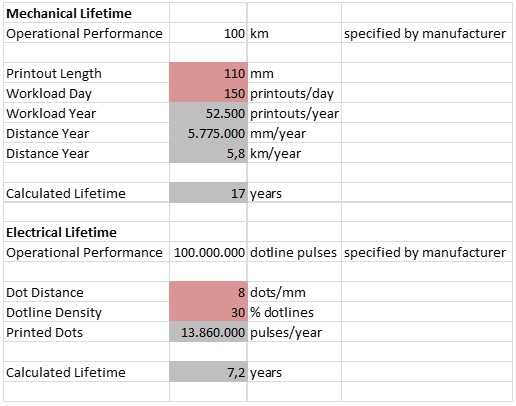
Once all the critical and less critical decisions regarding the application on the printer’s features, options and performance have been made and the product is integrated into the system and up and running we would like to know the throughput and lifetime data of the application. How long will the application be able to render its service? While not a requirement you should know what the average number of printouts per day and the average printout length. What will be printed on the printout? This allows the calculation of printer life data that is otherwise a guess.
There are two ways of calculating the printer life data; electrically and mechanically. We have included a model calculation in this paper based on some random assumptions that we made.
There are some questions that you would have to ask yourself while doing the lifetime calculation:
Based on the questions above we made assumptions for a lifetime calculation.

The operational performance of the printer is specified by the manufacturer. The red marked fields are based on assumptions that we made. For the mechanical life we are assuming a printout length of 110 mm per printout and that the application will make 150 printouts per day. As dot line density we 30% for the electrical lifetime. The grey fields are all calculated fields.
The calculation behind the grey marked fields is the following:
Of course, there are more and detailed ways to calculate the lifetime of the printer, but this is just a simple model to give you an idea on how to go about lifetime calculation and what needs to be considered.
The HENGSTLER team is expert in matching printers to the application. Whether it’s gas pump receipts, bank statement printers, railway ticketing systems, kiosks, fire alarm systems, or just about anything else, we’ve seen it and can help locate and integrate the best-suited printer for the purpose needed. Moreover, we can support our customers effectively by offering tailor-made application projects. Contact us today with your application or challenge